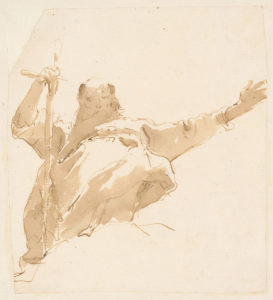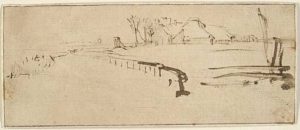Drawing is probably the most personal of the visual arts. In oil painting, an artist can hide behind technique, leaving a flawless surface that covers layers of work and reveals little of how the magic was accomplished. Not so with drawing. Everything is right there on the surface. And, in the lines left on the paper, we see the movements of the artist’s hand and the simultaneous working out of ideas.

Giovanni Tiepolo: “Old Man with a Sword.” Creating bright light with contrast.
The golden age of drawing stretched from the early Renaissance to the late 19th century, roughly the period covered by “Master Drawings From the Hermitage and Pushkin Museums,” at the Pierpont Morgan Library. The 120 works provide an overview of 500 years of European draftsmanship, with everything from preparatory sketches and life studies to finished compositions with the richness of paintings.
The two Russian museums from which these works come are renowned for the depth and quality of their holdings. The Hermitage’s 40,000-sheet collection of drawings was begun by Empress Catherine II (1729-1796) and includes works by such towering figures as Rembrandt, Rubens, Van Dyck, Veronese, and Claude Lorrain. The smaller and younger collection of the Pushkin Museum, assembled mostly by the donations of private collectors from Moscow, is strong in modern works from the mid-19th through the mid-20th centuries, with drawings by the modern masters such as Renoir, Degas, Van Gogh, Picasso, Matisse, Klee, and Modigliani.
But this is not necessarily a show dominated by great names. Lesser-known artists are just as likely to capture our fancy.
We may never have heard, for example, of the 16th century Florentine painter Giovanni Antonio Sogliani, but we are immediately drawn to his “Head of a Young Male Saint.” Softly rendered in a muted chiaroscuro with black and white chalks, the face has an expression of saintly transcendence that only Italian artists can carry off.
For centuries, the art of draftsmanship has meant the ability to render the human figure, particularly its movement and action. Giuseppe Cesari shows his mastery of this in “The Martyrdom of Saint Matthew,” in which two dagger-wielding soldiers bear down on the old man. They have the bodies of gods, these near-naked assailants, and the artist makes us feel the force and strength of their assault.
Jump forward several hundred years to the 19th century and we see Jean-Francois Millet handling a similar problem in “Death and the Woodcutter.” This is a much rougher sketch, but among the confused and seemingly careless strokes of charcoal we can see a similar movement, as Death raises his hand over the cowering peasant.

Rembrandt: “Landscape in Winter”
The beauty of a drawing is often its abstract nature, the way it forces us to fill in details with our mind. The landscapes of Rembrandt are a perfect example of this less-is-more aesthetic. With a few strokes of the pen, he summons up a snow-covered landscape, leaving the foreground entirely blank and rendering, with rapid, graceful strokes of the pen, a house nestling into a clump of trees.
Some artists draw with tone rather than line. Using washes of brown ink, the Venetian artist Giovanni Battista Tiepolo rendered figures almost entirely in dark and light values, so that the scene – a boy pointing out some detail of a relief to several old men – seems starkly illuminated by a noon sun.
A similar use of brown wash in gradations of dark to light can be found in the work of the 19th century German romanticist Caspar David Friedrich. Viewed from the shadowy interior of a Gothic building, his owl perched in a arched window is backlit by bright light – the only place where the white of the page is allowed to show.
Lines can take on a life of their own as they spin off the hands of some artists. We can see this in Tiburzio Passarotti’s ink sketch of men loading camels. The beauty here is in the fluid, improvisatory execution, the movement of the pen, the way it glides across the surface of the paper in graceful swirls that seem to casually coalesce into contour lines.
In other drawings, we are more aware of the artist working out a problem, trying alternate solutions, as in Bartolomeo Passarotti’s studies of a woman climbing stairs. The two figures are nearly identical, with only slight variations in the turn of the head, the tilt of the shoulder, and the folds of the dress. And yet, these seemingly minor adjustments make the figure on the right far more engaging.

